Effects of leaf removal and cluster thinning on berry quality of Vitis vinifera cultivars in the region of Weibei Dryland in China
SONG Chang-zheng, WANG Chao, XlE Sha, ZHANG Zhen-wen,
1 College of Enology, Northwest A&F University, Yangling 712100, P.R.China
2 Shaanxi Engineering Research Center for Viti-Viniculture, Yangling 712100, P.R.China
1. lntroduction
Canopy management includes a series of viticultural practices such as trellis system, vigor controlling, shoot trimming, cluster thinning and leaf removal, and they have been widely used throughout the world in grape production for many years (Osrecak et al. 2015; Song et al.2015; Sivilotti et al. 2016). They can change the canopy microclimate of grapevine by modifying sunlight exposure,vine temperature and air circulation and so on to affect the vine growth and quality of grape and subsequence wine(Duncan et al.1995; Reynolds et al. 1996; Tardaguila et al.2008).
Leaf removal around the fruit clusters has been commonly applied in cool climate viticultural regions around the world, and many studies have shown notable effects of such practice on the quality parameters of mature grape(Poni et al. 2013; Risco et al. 2014; Baiano et al. 2015; Song et al. 2015; Osre?ak et al. 2016). Timing and intensity of leaf removal are the most important factors that determine the final effect on grape quality (Intrigliolo et al. 2014;Sternad Lemut et al. 2015; Acimovic et al. 2016). Some researches have indicated that earlier leaf removal could effectively improve the quality of grape and wines (Intrigliolo et al. 2014; Sternad Lemut et al. 2015). On the other hand,other reports suggested that earlier onset of ripening that occurs often in the hot seasons could lead to unbalanced wines, and late apical leaf removal was a tool for delaying ripening and consequently modify the wine quality (Palliotti et al. 2013a, b; Poni et al. 2013).
The crop load of grape is another factor that closely related to the fruit quality and it influences the yield and quality in the next year to a large extent as well (Gil et al.2013). In the study by Palliotti et al. (2000), significant reduction of yield could be achieved when 40% or more clusters were thinned. Gil et al. (2013) reported that cutting 50% of the clusters at mid-veraison could reduce grape yield per vine by around 40%. In the study on Doonuri grape by Chang et al. (2015), the grapes with less 1.5 tons per 10 acres were best for producing high quality wine. As for the timing of thinning, previous study showed that cluster thinning at 8 weeks after flowering was best for improving grape quality (Kok 2011). Too early cluster thinning may lead to the reduction of photosynthetic rate and furtherly restricted the accumulation of sugar in the rest berries(Fanzone et al. 2011).
Due to the difference of cultivar, climate, vineyard location,rootstock and other factors, the same combination of leaf reamoval and cluster thinning protocol may lead to conflicting results. Therefore, determining appropriate protocol for the given cultivar growing in special grape region is vital for producing high quality grapes and wines. The semi-arid area Weibei Dryland is an important wine production region in northwestern China. Wine grapes grown there do not have to be buried to overwinter making this area a promising region for wine production. However, the warm climate and insufficient light exposure during berry ripening negatively affect the quality of grapes and wines. The aim of present study was to modify the microclimate of vine canopy by combination of leaf removal and cluster thinning, providing theoretical basis for grape and wine production in regions with similar ecological conditions around the world. According to results of previous researches (Kok 2011; Poni et al. 2013), both leaf removal and cluster thinning were performed before veraison (55 days after anthesis), and the orthogonal experiment with 2 factors of 3 levels were carried out in vintage of 2013 and 2014.
2. Materials and methods
2.1. Plant materials and field trial
The vineyard of red variety Vitis vinifera cv. Cabernet Sauvignon (CS) and white variety V. vinifera cv. Ugni Blanc(UB) were located in Kou Town and Beiyu Town in Jingyang County, Xianyang City, Shaanxi, China, respectively. The region belongs to the Weibei Plateau which characterized by a semiarid continental monsoon climate with 2 195.2 h of sunshine, 4 330°C of active accumulated temperature annually and an average frost-free period of 213 days per year. The average low temperature in winter and high temperature in summer were –6 and 34°C, respectively.And average annual precipitation was 548.7 mm.
The own-rooted vines were both planted in 2008 in north–south orientation. Spaces within and between the vine rows were 1.0 m×2.0 m for CS and 0.8 m×2.5 m for UB. Both of the varieties were moderately winter-pruned into bilateral cordon trellis, and water and fertilizer were controlled in conventional management ways.
At pre-veraison in late July (55 days after anthesis), 3 levels of basal leaf removal, 2, 4 and 6 leaves removed from base of the shoots, were conducted on the 2 varieties.Meanwhile, 3 levels of crop load by cluster thinning (HL, high crop load; ML, middle crop load; LL, low crop load) were set,which were 16, 33 and 66% of clusters thinned per plant.Among these treatments, 2 leaves removal and high crop load (2 HL, Table 1) was the most similar way with the local conventional management. Randomized block design with three replications was used, and each treatment replicate contained at least 15 vines.
2.2. Sample collection and analysis of index
At the optimum technological maturity of each year, which was judged by ratio of sugar and acid content, a 500-berrysample was randomly collected from each replicate. All samples were transported in low-temperature to laboratory immediately and stored at ?40°C prior to subsequent analysis.
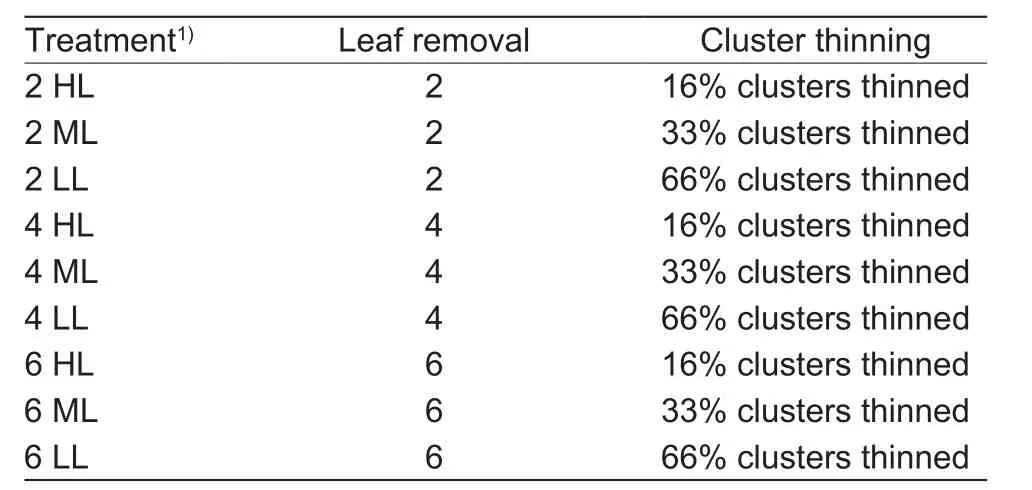
Table 1 Treatments of canopy managements for wine grape Vitis vinifera cv. Cabernet Sauvignon (CS) and Ugni Blanc (UB)
2.3. Determination of basic physicochemical parameters and phenols in berry skins
Reducing sugar (RS) and titratable acidity (TA) were determined with Fehling reagent and sodium hydroxide titration, respectively, according to the National Standard of the People’s Republic of China (GB/T 15038-2006). The berry pH was measured using PB-10 pH meter (Sartorius,Gottingen, Germany).
Phenols extraction was performed according to Song et al. (2015a). Total phenols (TP) content was determined by using the Folin-Ciocalteu method (Jayaprakasha et al.2001). Total anthocyanins (TAC) content was determined by the pH-differential method (Meng et al. 2012a). Tannin(TAN) was determined by the methyl cellulose precipitation(MCP) method (Sarneckis et al. 2006). The measurements were performed in triplicate.
2.4. Determination of anthocyanin profile
The extraction of anthocyanins was performed according to the method previously reported (Liang et al. 2014). The chromatographic analyses of anthocyanins were performed in twice for each sample using Shimadzu LC-20 A HPLC system(Shimadzu, Kyoto, Japan). A volume of 2 mL of extract was injected into the system and eluted by using a Hibar RT Lichrospher SB-C18 column (250 mm×4.6 mm, 5 μm) and detected at 520 nm. The mobile phase included solvent A(water/acetonitrile/formic acid, 800/100/25, v/v) and solvent B (water/acetonitrile/formic acid, 400/500/25, v/v). The gradient elution conditions were as following: 0.00–45.00 min,0–70% B; 45.00–50.00 min, 70% B; 50.00–51.00 min, 70–0%B; 51.00–55.00 min, 0% B. The column was held at 35°C and was flushed at a flow rate of 1.0 mL min–1.
2.5. Determination of polyphenol compounds
The extraction procedure of polyphenol compounds was completed in dark condition. The dried sample skin (2.0 g)was added into 3 mL water and 25 mL ethyl acetate, and shaken for 30 min at 130 r min–1and 25°C. Then the supernatant was collected and filtered through 0.45-μm organic membrane into an evaporation flask. Extraction of the residue was repeated 3 times in the same conditions.Thereafter, 3 supernatants were combined and evaporated to dryness under vacuum at 30°C and re-dissolved in 10 mL of chromatographic methanol. The methanol extract was injected into a Shimadzu HPLC System and analyzed according to the previous method (Meng et al. 2012b).Polyphenol compounds were identified by comparing their retention times with those of pure standards and by spiking the samples with standard solutions. Quantification of the compounds was made by using the external standard method (Meng et al. 2012b). And the subclasses of polyphenol compounds were calculated. The measurements were performed twice for each sample.
2.6. Determination of volatile compounds
Fifty frozen berries were pounded to pieces in a mortar,and the obtained residue was homogenized with a chilled pulverizer after the seeds was removed. After 2.5 h standing, the homogenate was centrifuged at 8 000 r min–1for 20 min at 4°C. The supernatants (10 mL) was transferred into a 15-mL sample vial, which contained 2 g NaCl and 50 μL 0.234 g L–12-octanol, and then the SPME extraction and GC-MS analysis were conducted according to the methods in previous research (Zhang et al. 2013; Song et al. 2015b).The 2-octanol was used as internal standard substance for quantification. The volatile compounds were identified by comparing mass spectra of the sample with those from pure standards injected in the same conditions, and with those found in the NIST2.0 MS Library Database or in the literatures. The quantification of most volatile compounds was achieved using internal standard quantification method.For the quantification of those had no pure reference compounds, the quantification was achieved using the calibration graphs of the compounds with the most similar chemical structure according to formula and chemical character (Tao et al. 2008). Afterwards, contents of volatile compound subclasses were calculated.
2.7. Statistical analysis
Significant differences were assessed with one-way analysis of variance (ANOVA), and statistical differences between the means were evaluated using least significant difference(LSD) analysis at the P=0.05 level. For experimental variables, two-way ANOVA was applied with leaf removal and cluster thinning as the principal factors. Statistical data processing was performed using the software SPSS Statistics 20.0 for Windows (IBM, Armonk, NY, USA).
3. Results
3.1. General quality parameters of mature grape
Sugar, acids and phenols are the primary parameters that determine the general quality of grape. Among the leaf removal and cluster thinning treatments, the treatment 2 HL was most similar with the local conventional management.Therefore, treatment effects could be found by comparing the parameters with that of 2 HL.
The effect of comprehensive canopy managements on general quality parameters of mature grape in two consecutive years are showed in Table 2 (2013) and Table 3 (2014). In the year of 2013, the treatments did not significantly affect the content of RS in grape berry of CS.The total acid content under all other treatments decreased compared with treatment 2 HL, while no evident difference was found among the pH of berry juice in different treatment groups. The content of TP, TAN and TAC in most treatments was higher than that in 2 HL, and the most effective treatments were 2 ML, 4 ML and 4 LL. In the year of 2014,except for the significant enhancement in 2 ML and 4 LL,most treatments had no pronounced effect on RS content.The 2 ML, 4 LL, 6 HL and 6 ML reduced the content of TA,and the result was consistent with the notably higher pH of berries in these groups. Although the entire effects of these managements on general quality were not quite the same between the two years, promoting effects of 4 LL in both years were still notable. According to the results of two-way ANOVA, significant effects of both leaf removal and cluster thinning on contents of TP and TAC were found in both years.
As for UB, differences of RS contents among treatments were found, while the influence by treatments was not regular. Most treatments reduced the TA, which was also agreed well with the higher pH in the same treatments.Additionally, TP and TAN was also notably higher in most treatments than that in 2 HL in 2013. Due to the climate factors, such as more rain, the RS content in 2014 was generally lower than that in 2013, while the promoting effect was more significant for most treatments in this year. Similar influence was obtained on TA and pH in the second year.Whereas, the effects on TP and TAN in 2014 were not as notably as in 2013. The two-way ANOVA showed that the effects of leaf removal on TP and cluster thinning on RS were highly significant in both years.
It was worth noting that the comprehensive canopy managements could effectively influence the general qualityof mature grape in both years. Therefore, in 2014, further analysis was conducted on the profiles of monomeric anthocyanins, non-anthocyanins phenolic compounds and volatile compounds of mature berries in those treatment groups.
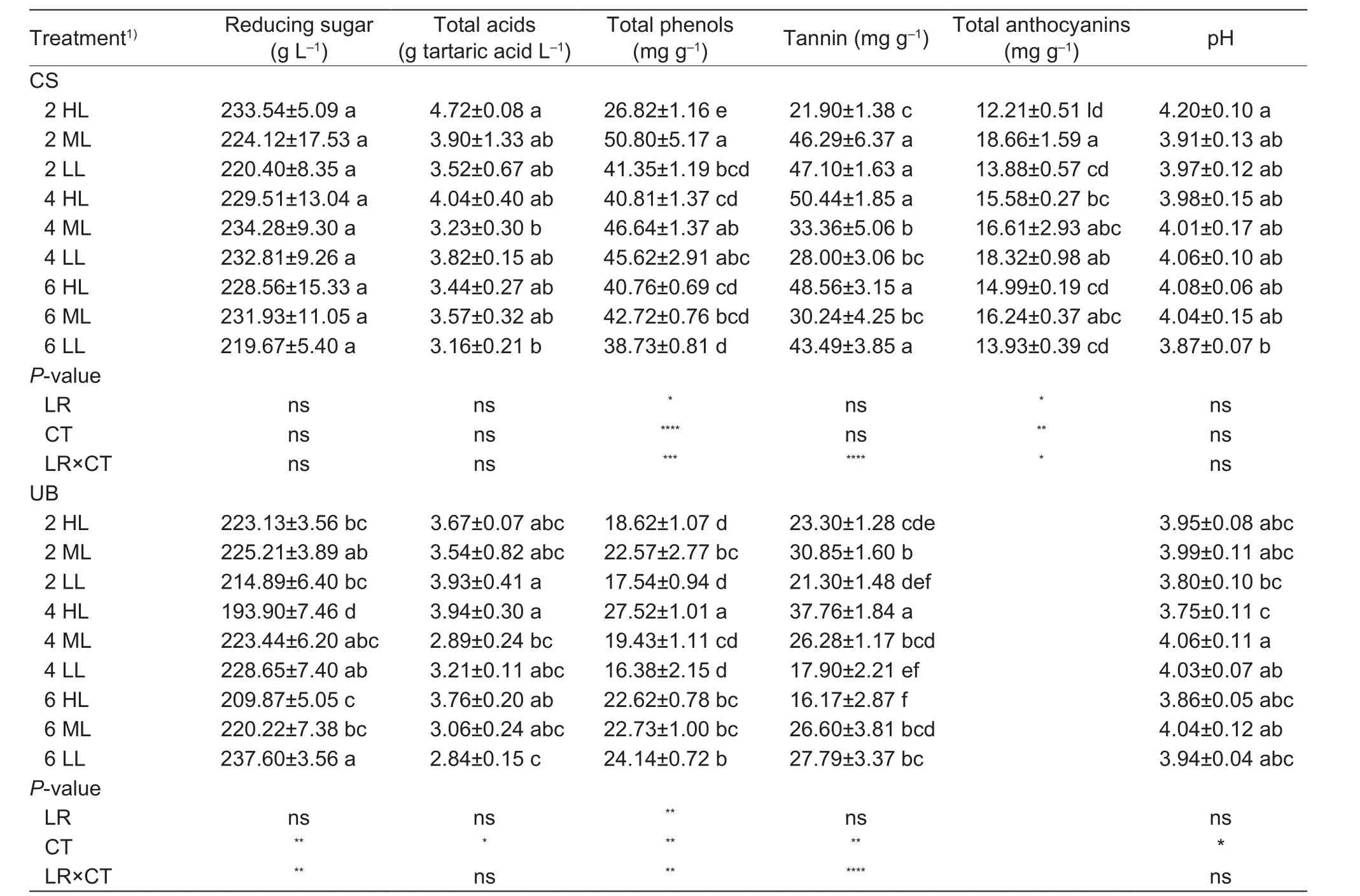
Table 2 General quality parameters of mature Vitis vinifera cv. Cabernet Sauvignon (CS) and Ugni Blanc (UB) berries (2013)
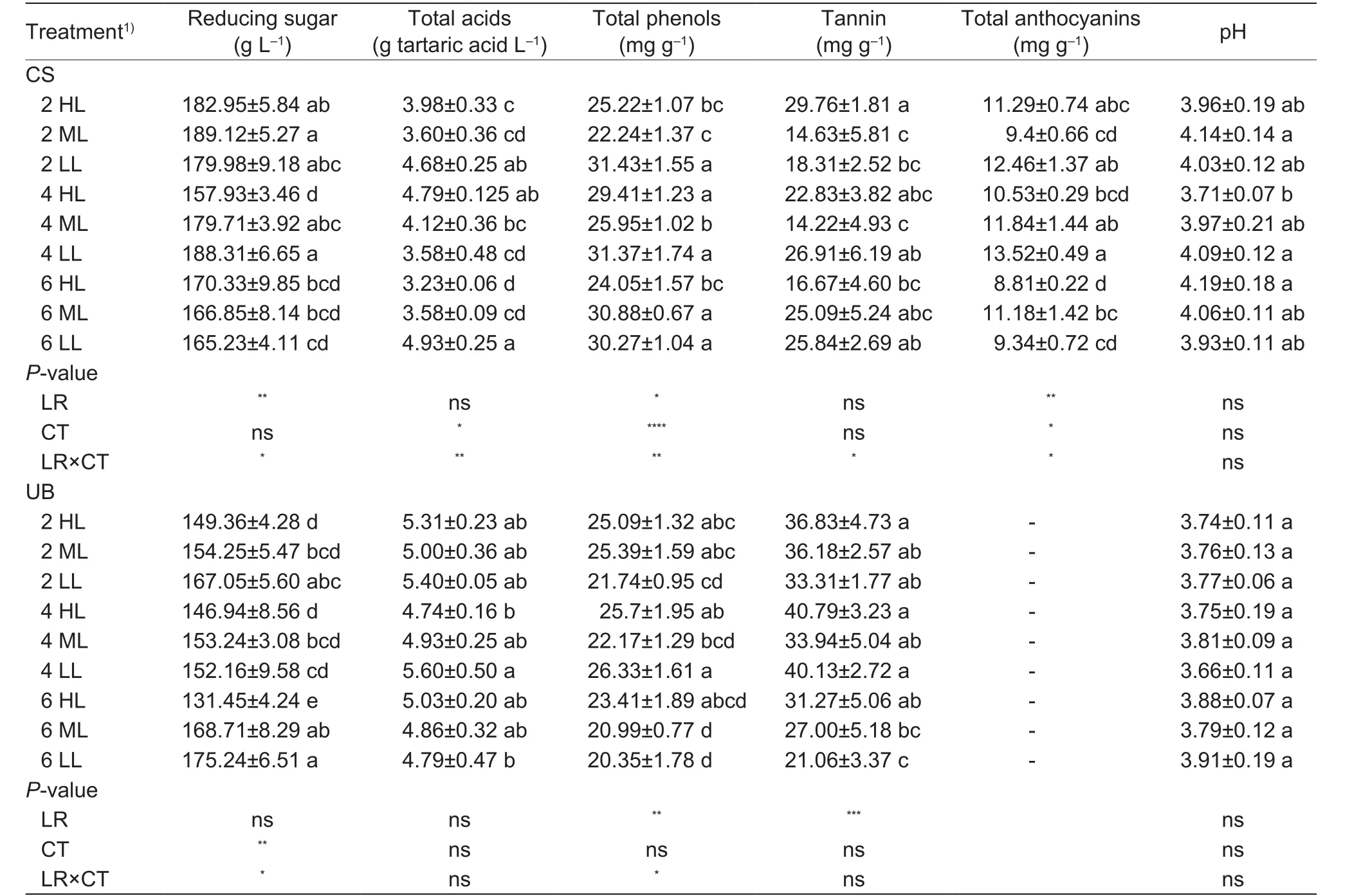
Table 3 General quality parameters of mature Vitis vinifera cv. Cabernet Sauvignon (CS) and Ugni Blanc (UB) berries (2014)
3.2. Anthocyanins profiles of CS grape
As shown in Table 4, a total of 9 monomeric anthocyanins compounds were detected. The concentration of total monomeric anthocyanins ranged from 5.37 to 12.48 mg g–1. The relative content of total monomeric anthocyanins in all treatments was not coincided with that of TAC using the pH-differential method. The reason might be the different expression methods. TAC was directly expressed as milligrams of cyanidin-3-monoglucoside equivalence per gram of dry berry skin (mg ME g–1DW), while actually the molecular weights of different primitive anthocyanidins were quite different, and the pH-differential method could not distinguish the different primitive anthocyanidins and whether they were acylated. Besides, leaf removal had more significant effects on the contents of monomeric anthocyanins compounds.
Fig. 1 showed the percentages of 5 individual anthocyanidins in total content of monomeric anthocyanins and acylation percentages. Malvidin and its derivatives were the most abundant anthocyanidins, and they took a percentage ranging from 74.39% (4 LL) to 82.19%(4 HL). Previous study showed that shading treatment could increase the percentage of malvidin and its derivatives(Downey et al. 2004), the lower percentage in treatments the higher intensity of leaf removal, which agreed well with that conclusion. Particularly, the lower malvidin percentage in 4 LL could also well explain the lower concentration of total monomeric anthocyanins, due to its higher molecular weights and more acylated derivatives. Petunidin and peonidin were the second abundant anthocyanidins of which the percentages ranged from 3.53 to 5.41% and from 8.62 to 12.94%, respectively. The other anthocyanidins, delphinidin and cyanidin, together accounted for a small percentage.The results were similar with that of other studies (Lee and Skinkis 2013; Feng et al. 2015). Notably, significant effectsof leaf removal and cluster thinning on most anthocyanidins were found.
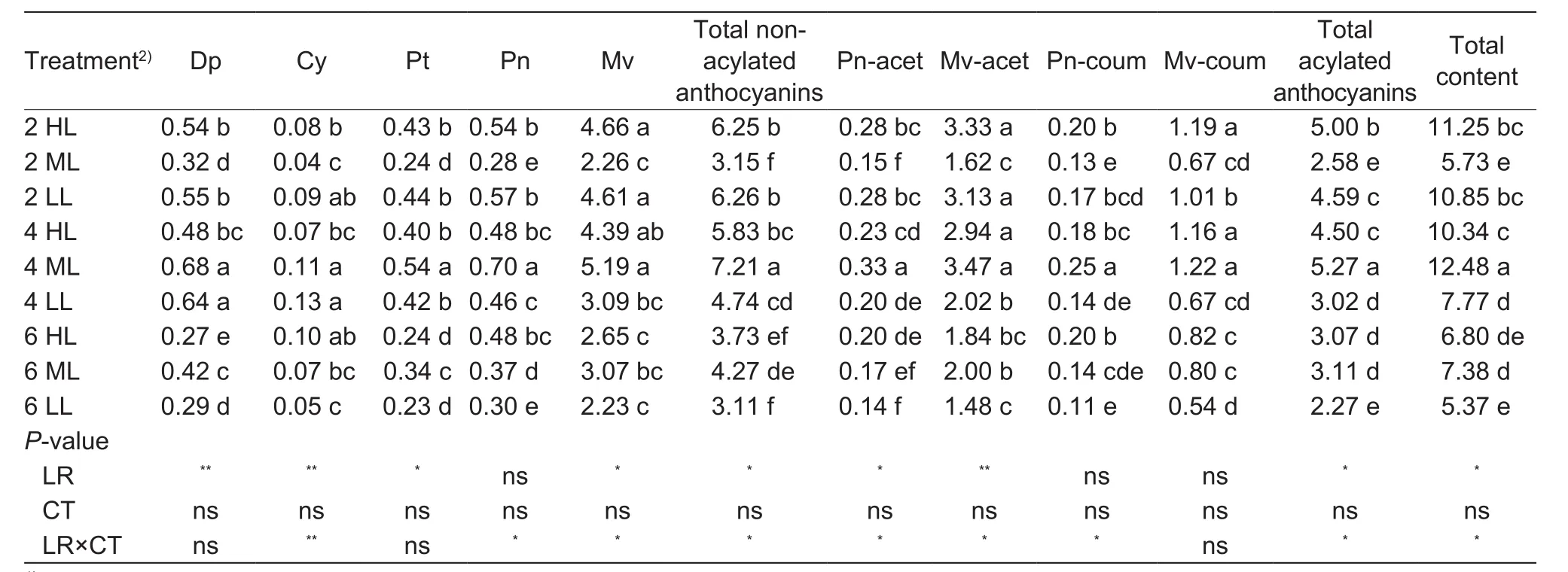
Table 4 The concentration of monomeric anthocyanins in Vitis vinifera cv. Cabernet Sauvignon (CS) berries (2014) (mg g–1 skin DW)1)
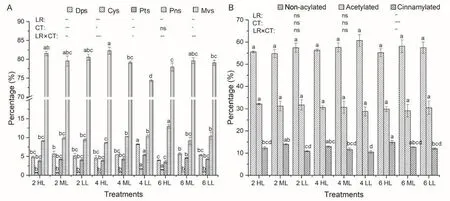
Fig. 1 Percentages of 5 anthocyanidins (A) and acylation percentages (B) in Cabernet Sauvignon (CS) berries in 2014. Dps,delphinidin; Cys, cyanidin; Pts, petunidin; Pns, peonidin; Mvs, malvidin. HL, high crop load; ML, middle crop load; LL, low crop load. P-values of the ANOVAS of leaf removal (LR), cluster thinning (CT) and their interactions (LR×CT) are indicated. *, P<0.05; **,P<0.01; ***, P<0.001; ****, P<0.0001; ns, not significant. Different letters for the same anthocyanidin indicate a statistically significant difference at 5% level. Bars indicate the standard deviation of anthocyanidin percentages.
Fig. 1-B showed a notable influence of canopy managements on the acylation percentages of anthocyanidins. Non-acylated anthocyanins were the most abundant in all samples, which took percentages from 54.85 to 61.00%. It was worth noting that among the same leaf removal treatments, the percentages of cinnamylated anthocyanins decreased with the decrease of grape crop load. On the other hand, the percentages of non-acylated anthocyanins were lower in higher crop loading treatments.
3.3. Non-anthocyanin phenolics
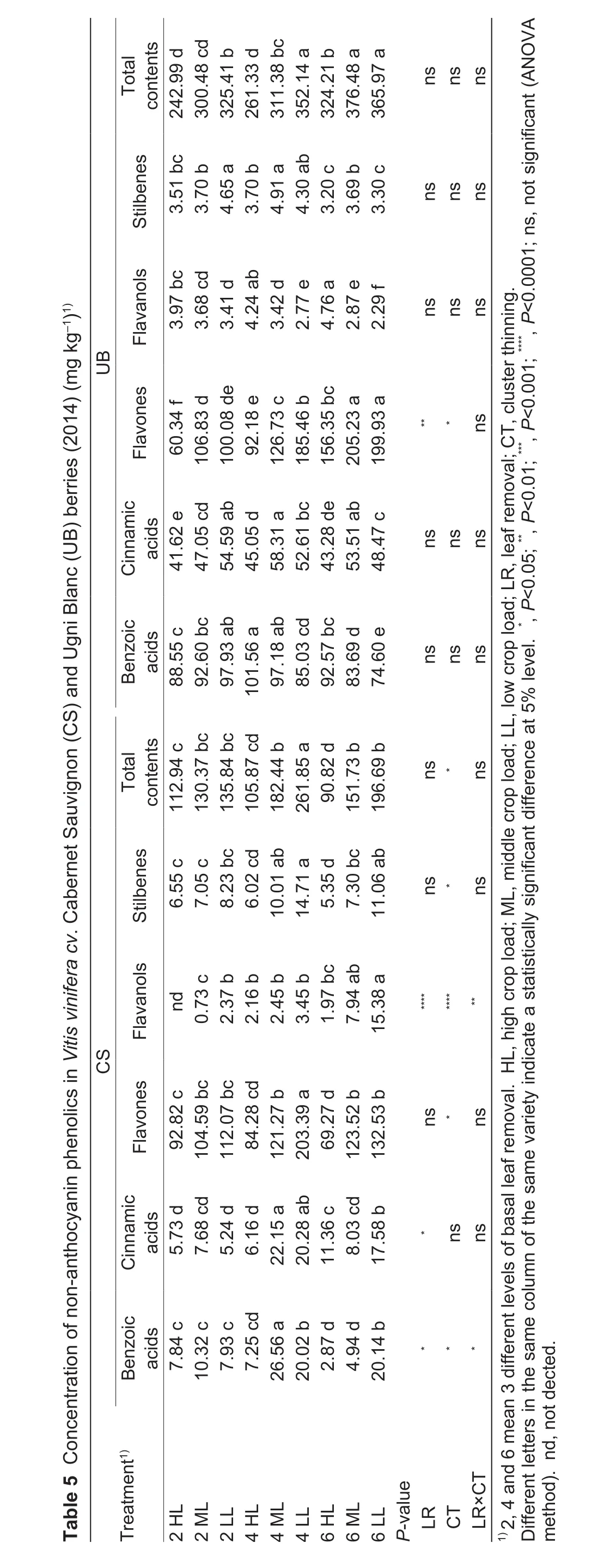
As for the influence of canopy managements on the accumulation of non-anthocyanin phenolics, similar treatment effect was found on the two wine grape varieties(Table 5). Regardless of leaf removal treatments, the total content was higher in lower crop loading groups. Cluster thinning showed more significant effects than leaf removal.The highest three treatments were 4 LL, 6 LL and 4 ML for CS and 6 ML, 6 LL and 4 LL for UB, respectively. Flavonols were the dominate phenolics among the five categories. And its relative contents among different treatments were identical with that of TP. The accumulation of benzoic acids and cinnamic acids had different responses to the treatments for different varieties. In general, the mean and low crop loads enhanced the synthesis of benzoic acids in CS and cinnamic acids in UB as well. Interestingly, the content of flavanols had opposite responses in the two varieties. The lower crop load increased the flavanols contents in CS while decreased that in UB. Stilbenes were in trace amount for all samples,but promoting effect of lower crop load could still be noted for both varieties.
3.4. Volatile compounds
The content of volatile compound subclasses in the two wine grape berries were showed in Table 6. The total concentration of the volatile compounds in CS ranged from 925.34 μg L–1(2 HL) to 1 685.98 μg L–1(4 HL), and the treatments of 4 leaves removal had higher concentrations on average. On the other hand, cluster thinning had no notable effect on the total concentrations. Acids, alcohols and esters were 3 dominating volatiles, which took a percentage over 95% of the total volatiles in each sample. It is worth noting that the middle level’s treatments (2 LL, 4 HL, 4 ML, 4 LL and 6 HL) were beneficial for the synthesis of the three volatiles. Among these treatments,4 HL had quite higher concentrations of acids, alcohols, esters and owned the highest total concentration. The total variety numbers of volatiles ranged from 20 (4 ML and 6 ML) to 30(2 LL and 4 LL) (Appendix A), and the 3 treatments that had the highest total concentrations also had the most abundant volatile varieties (2 LL, 4 HL and 4 LL). Acids, alcohols and esters were also the volatiles that contained the most varieties. And the amount of those compounds determined the entire complexity of the volatile compounds to a great extent.
The total concentrations of the volatile compounds in UB ranged from 362.79 μg L–1(4 HL) to 1 923.99 μg L–1(6 LL),and the treatments of 6 leaves removal (6 HL, 6 ML and 6 LL) had higher concentrations on average. Different from CS, aldehydes other than acids were the most abundant volatiles of most UB samples. For each subclass of volatiles,the concentrations were quite different among the treatments,and both leaf removal and cluster thinning had significant effects on most subclasses of volatiles. Additionally, similar effects were found on the volatile variety of UB. Namely,samples under the middle level’s treatments owned more varieties of volatiles (Appendix A). Same with CS, 2 LL, 4 HL and 4 LL were also the treatments that had the most volatile varieties for UB.
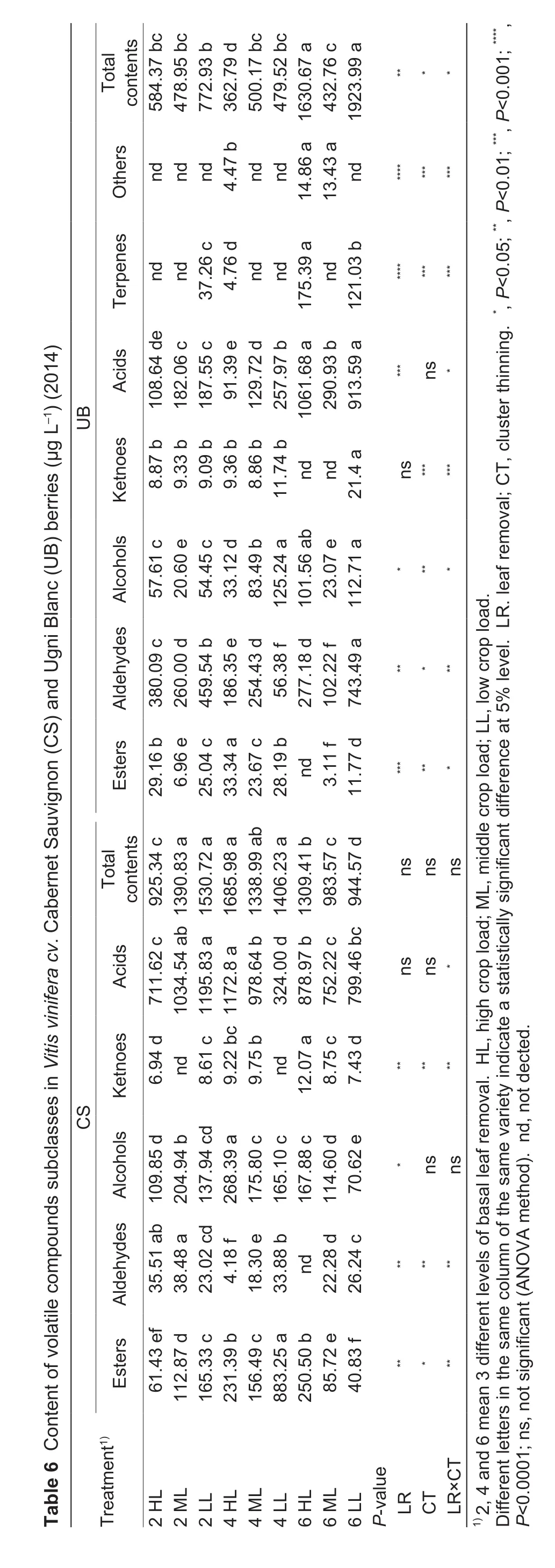
4. Discussion
Grapevine canopy management is a vital practice for improving quality of vine, berry and subsequent wine, and it has provoked many studies around the world. However,inconsistent results were obtained probably due to the different management operations, local climatic conditions, cultivars and even rootstocks (Feng et al. 2015). Hence, searching for an optimum management mode is still very important for wine grape production.
In present study, no evident influence of the treatments on sugar content was found, which was similar to the results obtained by other researchers (Chorti et al. 2010; Tardaguila et al. 2010; King et al. 2012). The result suggested that six at most basal leaf removal was enough to support grape berry development and ripening in all crop loading levels.
Regarding to TA, previous study showed that cluster thinning at both pre-flowering and lag-phase of berry growth could result in low titratable acidity and high pH (Gatti et al. 2012).Others showed that defoliated vines, without cluster thinning,produced the lowest total titratable acidity in grapes (Bergqvist et al. 2001; Almanza-Merchán et al. 2011). Bavaresco et al.(2008) concluded that acidity was affected by leaf removal differently depending on meteorological conditions and cultivar.The present study indicated that these treatments of canopy managements in the region of Weibei Dryland could reduce TA in berries. This effect is meaningful for wine production in regions where the grape acidity is commonly high.
The quantitative and qualitative profiles of anthocyanins largely determine the grape and wine color. Many researches showed that leaf removal and cluster thinning can enhance the TAC content in both grape skin and subsequent wine(Gatti et al. 2012; Tardaguila et al. 2012; Sternad Lemut et al.2013; Intrigliolo et al. 2014; Matsuyama et al. 2014), which was mainly attributed to the increased sunlight exposure and temperature (Chorti et al. 2010; Feng et al. 2015). Similar result was obtained in this study on CS. Additionally, cluster thinning and leaf removal had different effects on individual compounds. The work of Filippetti et al. (2005) showed that cluster thinning reduced tri-substituted anthocyanins(Dp-3-glucoside, Pt-3-glucoside and Mv-3-glucoside) and increased di-substituted anthocyanins (Pn-3-glucoside and Cy-3-glucoside). And according to another research (Sternad Lemut et al. 2013), early leaf removal showed a reduction in peonidin glucoside but an increase in all other individual compounds. The changed leaf/fruit ratio among different treatments, together with the changed sun exposure and surrounding temperature, could promote either biosynthesis or degradation of anthocyanins (Fanzone et al. 2011).Therefore, it is reasonable that different combinations of leaf removal and cluster thinning treatments would result in different effects on monomeric anthocyanin profiles. In the work by Matsuyama et al. (2014), the overexpression of flavonoid 3′,5′-hydroxylase (F3′5′H) in the leaf removal grape skins suggested that leaf removal contributed to the accumulation of delphinidin-based anthocyanins in grape skin. Present study also showed evident increase of delphinidin-based anthocyanins (2 ML, 4 ML, 4 LL and 6 ML) in most treatments, indicating the advantage of proper treatments for producing dark-colored red wine.
Previous researches have indicated that leaf removal could increase the content of phenolics in grape and resultant wine, maintaining the complexity and balance of wine body(Tardaguila et al. 2012; Intrigliolo et al. 2014; Osrecak et al.2015; Song et al. 2015). Similar results were obtained in this study, and the effect was more evident on UB. In addition,cluster thinning also effectively enhanced the accumulation of phenolics according to the results. Chang et al. (2015)suggested that as cluster thinning increased, total polyphenol and total anthocyanin contents increased as well with earlier maturity. Another research on Cabernet Franc showed that cluster thinning was effective only in one of the experimental years (Zhuang et al. 2014). The difference was probably caused by the variance of cultivars and climate conditions.Phenolic acids are the most abundant phenolic compounds in grape juice and wine of white grapevine cultivars (Bubola et al. 2012), the results of UB also agreed with this view.Leaf removal has been shown to improve the accumulation of hydroxycinnamics (Bubola et al. 2012; Diago et al. 2012),and the concentration of phenolic acids in grape and wine of white cultivars could be managed by altering the timing of leaf removal according to the desired wine style (Bubola et al. 2012). In present study, the combination of mean level of leaf removal and cluster thinning was the most favor to the accumulation of phenolic acids. Flavones are important phenolic components especially for red cultivars. Our and others’ studies showed a notable influence for this subclass of phenolics (Sternad Lemut et al. 2011; Bubola et al. 2012;Diago et al. 2012). As for flavanols and stilbenes, previous studies showed that leaf removal could positively affect their content in grapes and resultant wines (Bavaresco et al.2008; Osrecak et al. 2015). Present study also showed a pronounced effect of cluster thinning on content of these compounds, particularly for flavanols.
The accumulation of free and glycosylated aroma compounds commonly occurs at the advanced stages of ripening when sugar increase has already slowed down(Coombe and McCarthy 2000), so the maturity of grape greatly influences its aromatic character. According to Poni et al. (2013), limiting crop load could cause earlier ripening while leaf removal could delay this procedure. Therefore,proper combination of cluster thinning and leaf removal could be beneficial for the maturity and aromatic character of grape. Other researches also showed the effects of leaf removal and/or cluster thinning on grape and wine aroma(Borghezan et al. 2011; Feng et al. 2015; Song et al. 2015).Research by Song et al. (2015) concluded that canopy management by improving sun exposure promoted the formation of varietal aroma compounds like monoterpenes and C13-norisoprenoids, and another study (Feng et al.2015) also indicated that cluster zone leaf removal could positively influence the content of beta-damascenone in mature grape. We got the similar results in present study on the white grape variety UB. Although many studies have shown significant effects of canopy managements on modifying wine aroma, systematical study about the influence on grape aroma is still limited. In this research,pronounced effects of leaf removal and cluster thinning on aroma content and variety in grape were found.
5. Conclusion
Orthogonal experiment was conducted to study the effect of leaf removal and cluster thinning on grape quality in Weibei Dryland of China in 2013 and 2014. The results showed that the treatments had no influence on content of RS in both varieties. The TA, by contrast, was generally decreased by leaf removal and cluster thinning. Similar to previous researches, accumulations of TP, TAN and TAC were promoted by most treatments. Content and percentage of monomeric anthocyanins in Cabernet Sauvignon grape were also influenced by leaf removal and cluster thinning.Leaf removal decreased the percentage of malvidin and its derivatives. Meanwhile, among cluster thinning treatments,the middle and low crop loads led to larger percentages of petunidin, peonidin, delphinidin and cyaniding. Besides,cinnamylated anthocyanins decreased with the intensity of cluster thinning. As for non-anthocyanin phenolics, similar treatment effect was found on the two grape varieties. The middle degree of leaf removal and cluster thinning enhanced the accumulation of phenolic acids most. Moreover,pronounced increase of flavanols and stilbenes contents were found with the increase of cluster thinning. Additionally, the treatments also had notable effects on content and variety of aroma compounds in both grape varieties, particularly for the white grape cultivar Ugni Blanc.
Acknowledgements
This work was supported by the China Agriculture Research System for Grape Industry (CARS-29-zp-06).
Appendixassociated with this paper can be available on http://www.ChinaAgriSci.com/V2/En/appendix.htm
Acimovic D, Tozzini L, Green A, Sivilotti P, Sabbatini P. 2016.Identification of a defoliation severity threshold for changing fruitset, bunch morphology and fruit composition in Pinot Noir. Australian Journal of Grape and Wine Research, 22,399–408.
Almanza-Merchán P J, Fischer G, Serrano-Cely P A, Balaguera-López H E, Galvis J A. 2011. Effects of leaf removal and cluster thinning on yield and quality of grapes (Vitis vinifera L., Riesling×Silvaner) in Corrales, Boyaca (Colombia).Agronomía Colombiana, 29, 35–42.
Baiano A, De Gianni A, Previtali M A, Del Nobile M A, Novello V,de Palma L. 2015. Effects of defoliation on quality attributes of Nero di Troia (Vitis vinifera L.) grape and wine. Food Research International, 75, 260–269.
Bavaresco L, Gatti M, Pezzutto S, Fregoni M, Mattivi F. 2008.Effect of leaf removal on grape yield, berry composition,and stilbene concentration. American Journal of Enology and Viticulture, 59, 292–298.
Bergqvist J, Dokoozlian N, Ebisuda N. 2001. Sunlight exposure and temperature effects on berry growth and composition of Cabernet Sauvignon and Grenache in the Central San Joaquin Valley of California. American Journal of Enology and Viticulture, 52, 1–7.
Borghezan M, Pit F A, Gavioli O, Malinovski L I, da Silva A L. 2011. Effect of leaf area on the grpae composition and sensory quality of wines from cultivar Merolt (Vitis vinifera L.)in S?o Joaquim, SC, Brazil. Ciência e Técnica Vitivinícola,26, 1–10.
Bubola M, Persuric D, Ganic K K, Karoglan M, Kozina B. 2012.Effects of fruit zone leaf removal on the concentrations of phenolic and organic acids in istrian malvasia grape juice and wine. Food Technology and Biotechnology, 50,159–166.
Chang E, Park K, Jeong S, Hur Y, Choi I. 2015. Cluster thinning effects on the fruit and wine quality of ‘doonuri’ grape. Acta Horticulturae, 1082, 321–326.
Chorti E, Guidoni S, Ferrandino A, Novello V. 2010. Effect of different cluster sunlight exposure levels on ripening and anthocyanin accumulation in nebbiolo grapes. American Journal of Enology and Viticulture, 61, 23–30.
CooMbe B G, McCarthy M. 2000. Dynamics of grape berry growth and physiology of ripening. Australian Journal of Grape and Wine Research, 6, 131–135.
Diago M P, Ayestaran B, Guadalupe Z, Garrido A, Tardaguila J.2012. Phenolic composition of Tempranillo wines following early defoliation of the vines. Journal of the Science of Food and Agriculture, 92, 925–934.
Downey O, Harvey S, Robinson P. 2004. The effect of bunch shading on berry development and flavonoid accumulation in Shiraz grapes. Australian Journal of Grape and Wine Research, 10, 55–73.
Duncan R A, Stapleton J J, Leavitt G M. 1995. Population dynamics of epiphytic mycoflora and occurrence of bunch rots of wine grapes as influenced by leaf removal. Plant Pathology, 44, 956–965.
Fanzone M, Zamora F, Jofré V, Assof M, Pe?a-Neira á. 2011.Phenolic composition of Malbec grape skins and seeds from Valle de Uco (Mendoza, Argentina) during ripening.effect of cluster thinning. Journal of Agricultural and Food Chemistry, 59, 6120–6136.
Feng H, Yuan F, Skinkis P A, Qian M C. 2015. Influence of cluster zone leaf removal on Pinot noir grape chemical and volatile composition. Food Chemistry, 173, 414–423.
Filippetti I, Ramazzotti S, Centinari M, Bucchetti B, Intrieri C.2005. Effects of cluster thinning on grape composition:Preliminary experiences on ‘Sangiovese’ grapevines.International Workshop on Advances in Grapevine and Wine Research, 754, 227–234.
Gatti M, Bernizzoni F, Civardi S, Poni S. 2012. Effects of cluster thinning and preflowering leaf removal on growth and grape composition in cv. Sangiovese. American Journal of Enology and Viticulture, 63, 325–332.
GB/T 15038-2006. Analytical Methods of Wine and Fruit Wine.Standards Press of China, Beijing, China. (in Chinese)
Gil M, Esteruelas M, González E, Kontoudakis N, Jiménez J,Fort F, Canals J M, Hermosín-Gutiérrez I, Zamora F. 2013.Effect of two different treatments for reducing grape yield in Vitis vinifera cv. Syrah on wine composition and quality:Berry thinning versus cluster thinning. Journal of Agricultural and Food Chemistry, 61, 4968–4978.
Intrigliolo D S, Llacer E, Revert J, Dolores Esteve M, Dolores Climent M, Palau D, Gomez I. 2014. Early defoliation reduces cluster compactness and improves grape composition in Mando an autochthonous cultivar of Vitis vinifera from southeastern Spain. Scientia Horticulturae,167, 71–75.
Jayaprakasha G, Singh R, Sakariah K. 2001. Antioxidant activity of grape seed (Vitis vinifera) extracts on peroxidation models in vitro. Food chemistry, 73, 285–290.
King P D, McClellan D J, Smart R E. 2012. Effect of severity of leaf and crop removal on grape and wine composition of merlot vines in hawke’s bay vineyards. American Journal of Enology and Viticulture, 63, 500–507.
Kok D. 2011. Influences of pre- and post-veraison cluster thinning treatments on grape composition variables and monoterpene levels of Vitis vinifera L. cv. Sauvignon Blanc.Journal of Food, Agriculture and Environment, 9, 22–26.
Lee J, Skinkis P A. 2013. Oregon ‘Pinot noir’ grape anthocyanin enhancement by early leaf removal. Food Chemistry, 139,893–901.
Liang N, Zhu B, Han S, Wang J, Pan Q, Reeves M, Duan C, He F. 2014. Regional characteristics of anthocyanin and flavonol compounds from grapes of four Vitis vinifera varieties in five wine regions of China. Food Research International, 64, 264–274.
Matsuyama S, Tanzawa F, Kobayashi H, Suzuki S, Takata R, Saito H. 2014. Leaf removal accelerated accumulation of delphinidin-based anthocyanins in ‘Muscat Bailey A’ Vitis×labruscana (Bailey) and Vitis vinifera (Muscat Hamburg) grape skin. Journal of the Japanese Society for Horticultural Science, 83, 17–22.
Meng J, Fang Y, Gao J, Qiao L, Zhang A, Guo Z, Qin M,Huang J, Hu Y, Zhuang X. 2012a. Phenolics composition and antioxidant activity of wine produced from spine grape(Vitis davidii Foex) and cherokee rose (Rosa laevigata Michx.) fruits from South China. Journal of Food Science,77, C8–C14.
Meng J, Fang Y, Qin M, Zhuang X, Zhang Z. 2012b. Varietal differences among the phenolic profiles and antioxidant properties of four cultivars of spine grape (Vitis davidii Foex) in Chongyi County (China). Food Chemistry, 134,2049–2056.
Osre?ak M, Karoglan M, Kozina B. 2016. Influence of leaf removal and reflective mulch on phenolic composition and antioxidant activity of Merlot, Teran and Plavac mali wines(Vitis vinifera L.). Scientia Horticulturae, 209, 261–269.
Osre?ak M, Karoglan M, Kozina B, Preiner D. 2015. Influence of leaf memoval and reflective mulch on phenolic composition of white wines. Journal International des Sciences de la Vigne et du Vin, 49, 183–193.
Palliotti A, Cartechini A, Possingham J. V, Neilsen G. H. 2000.Cluster thinning effects on yield and grape composition in different grapevine cultivars. Acta Horticulturae, 512,111–119.
Palliotti A, Cini R, Silvestroni O, Leoni F, Poni S. 2013a.Effects of late mechanized leaf removal above the clusters zone to delay grape ripening in ‘Sangiovese’ vines. Acta Horticulturae, 978, 301–307
Palliotti A, Panara F, Silvestroni O, Lanari V, Sabbatini P,Howell G S, Gatti M, Poni S. 2013b. Influence of mechanical postveraison leaf removal apical to the cluster zone on delay of fruit ripening in Sangiovese (Vitis vinifera L.) grapevines.Australian Journal of Grape and Wine Research, 19,369–377.
Poni S, Gatti M, Bernizzoni F, Civardi S, Bobeica N, Magnanini E, Palliotti A. 2013. Late leaf removal aimed at delaying ripening in cv. Sangiovese: Physiological assessment and vine performance. Australian Journal of Grape and Wine Research, 19, 378–387.
Reynolds A G, Wardle D A, Naylor A P. 1996. Impact of training system, vine spacing, and basal leaf removal on riesling,vine performance, berry composition, canopy microclimate,and vineyard labor requirements. American Journal of Enology and Viticulture, 47, 63–76.
Risco D, Perez D, Yeves A, Castel J R, Intrigliolo D S.2014. Early defoliation in a temperate warm and semiarid Tempranillo vineyard: Vine performance and grape composition. Australian Journal of Grape and Wine Research, 20, 111–122.
Sarneckis C J, Dambergs R, Jones P, Mercurio M, Herderich M J, Smith P. 2006. Quantification of condensed tannins by precipitation with methyl cellulose: Development and validation of an optimised tool for grape and wine analysis.Australian Journal of Grape and Wine Research, 12, 39–49.
Sivilotti P, Herrera J C, Lisjak K, Ba?a ?esnik H, Sabbatini P,Peterlunger E, Castellarin S D. 2016. Impact of leaf removal,applied before and after flowering, on anthocyanin, tannin,and methoxypyrazine concentrations in ‘Merlot’ (Vitis vinifera L.) grapes and wines. Journal of Agricultural and Food Chemistry, 64, 4487–4496.
Song C, Liu M, Meng J, Chi M, Xi Z, Zhang Z. 2015a. Promoting effect of foliage sprayed zinc sulfate on accumulation of sugar and phenolics in berries of Vitis vinifera cv. Merlot growing on zinc deficient soil. Molecules, 20, 2536–2554.
Song C, Zuo L, Shi P, Meng J, Wang Y, Zhang Z, Xi Z.2015b. Aroma characterization of Chinese Hutai-8 wines:comparing with merlot and cabernet sauvignon wines.Scientia Horticulturae, 194, 237–245.
Song J, Smart R, Wang H, Dambergs B, Sparrow A, Qian M C. 2015. Effect of grape bunch sunlight exposure and UV radiation on phenolics and volatile composition of Vitis vinifera L. cv. Pinot noir wine. Food Chemistry, 173,424–431.
Sternad Lemut M, Sivilotti P, Butinar L, Laganis J, Vrhovsek U. 2015. Pre-flowering leaf removal alters grape microbial population and offers good potential for a more sustainable and cost-effective management of a Pinot Noir vineyard.Australian Journal of Grape and Wine Research, 21,439–450.
Sternad Lemut M, Sivilotti P, Franceschi P, Wehrens R,Vrhovsek U. 2013. Use of metabolic profiling to study grape skin polyphenol behavior as a result of canopy microclimate manipulation in a ‘Pinot noir’ vineyard. Journal of Agricultural and Food Chemistry, 61, 8976–8986.
Sternad Lemut M, Trost K, Sivilotti P, Vrhovsek U. 2011. Pinot Noir grape colour related phenolics as affected by leaf removal treatments in the Vipava Valley. Journal of Food Composition and Analysis, 24, 777–784.
Tao Y, Li H, Wang H, Zhang L. 2008. Volatile compounds of young Cabernet Sauvignon red wine from Changli County(China). Journal of Food Composition and Analysis, 21,689–694.
Tardaguila J, Blanco J A, Poni S, Diago P. 2012. Mechanical yield regulation in winegrapes: Comparison of early defoliation and crop thinning. Australian Journal of Grape and Wine Research, 18, 344–352.
Tardaguila J, Diago M P, Martinez de Toda F, Poni S, Vilanova M. 2008. Effects of leaf removal on yield, berry maturity,wine composition and sensory properties of cv. Grenache grown under non irrigated conditions. Journal International des Sciences de la Vigne et du Vin, 42, 221–229.
Tardaguila J, Martinez de Toda F, Poni S, Diago M P. 2010.Impact of early leaf removal on yield and fruit and wine composition of Vitis vinifera L. Graciano and Carignan.American Journal of Enology and Viticulture, 61, 372–381.
Zhang L, Tao Y, Wen Y, Wang H. 2013. Aroma evaluation of young Chinese Merlot wines with denomination of origin.South African Journal of Enology and Viticulture, 34, 46–53.
Zhuang S, Tozzini L, Green A, Acimovic D, Howell G S,Castellarin S D, Sabbatini P. 2014. Impact of cluster thinning and basal leaf removal on fruit quality of cabernet franc (Vitis vinifera L.) grapevines grown in cool climate conditions.Hortscience, 49, 750–756.
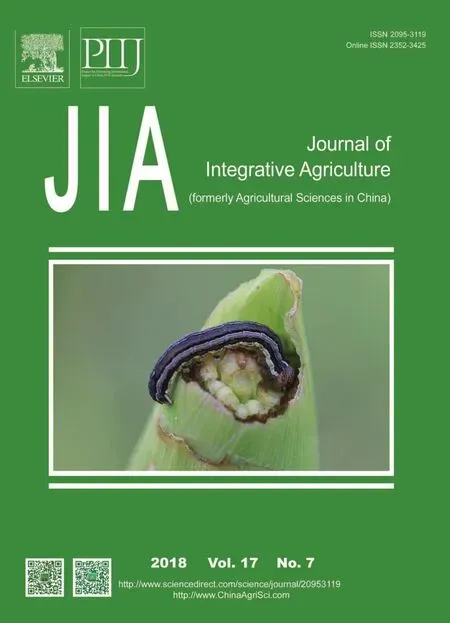 Journal of Integrative Agriculture2018年7期
Journal of Integrative Agriculture2018年7期
- Journal of Integrative Agriculture的其它文章
- Characterisation of pH decline and meat color development of beef carcasses during the early postmortem period in a Chinese beef cattle abattoir
- Multi-mycotoxin exposure and risk assessments for Chinese consumption of nuts and dried fruits
- Effects of 1-methylcyclopropene and modified atmosphere packaging on fruit quality and superficial scald in Yali pears during storage
- Insertion site of FLAG on foot-and-mouth disease virus VP1 G-H loop affects immunogenicity of FLAG
- Update of Meat Standards Australia and the cuts based grading scheme for beef and sheepmeat
- Light shading improves the yield and quality of seed in oil-seed peony (Paeonia ostii Feng Dan)
